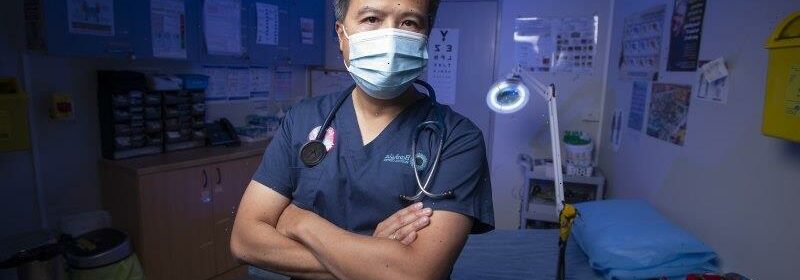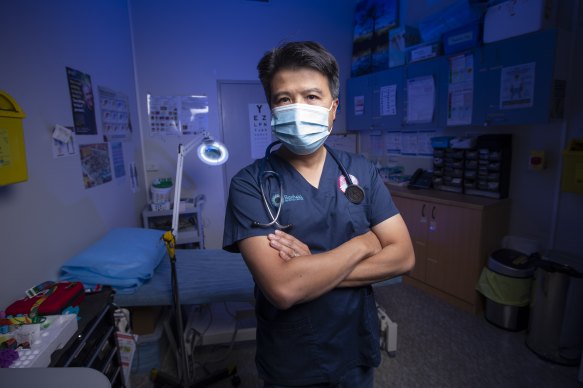Where you’re most and least likely to find a bulk-billing doctor

Fewer than 65 per cent of Australians now have all their GP appointments bulk-billed, but the biggest black spots are in the ACT and Tasmania where more than half the population cannot see a doctor without paying out-of-pocket fees.
Western and south-west Sydney have the highest bulk-billing rates in the country; more than nine in 10 patients have their GP visits fully subsidised, compared to just 55.7 per cent across town in northern Sydney. But western Sydney is an outlier, particularly compared with most regional health districts where doctor shortages are most acute.
Victorian GP Bernard Shiu said his clinic in Geelong had reduced its bulk-billing rate from up to 80 per cent to around 30 per cent over the last seven years. Credit:Wayne Taylor
The federal health department published a geographic breakdown of bulk-billing data for the first time on Monday, revealing disparities in how people access primary care across Australia as the government embarks on long-term reform of the system amid rising costs and workforce shortages.
The highest bulk-billing of patients in metropolitan Melbourne is in the north-west primary health network at 74.3 per cent, more than 10 percentage points higher than the 63.5 per cent in the south-east.
Dr Bernard Shiu said parts of the west and north of Melbourne had a higher rate of bulk billing, as patients in those areas expected to be bulk-billed.
“If you’re the only one there not bulk-billing you really have to offer something that no one else can”. Whereas other people in more affluent areas expected to pay a gap, he said. “As soon as they come out, they already have their credit card ready.”
In the cities, those least likely to see a bulk-billing doctor lived in Canberra (37.6 per cent), Brisbane North (55.1 per cent) and Perth North (55.4 per cent).
Access was worse outside metropolitan areas: only about half of people living in Tasmania (44.8 per cent), the Murray region (52.8 per cent), the Hunter, New England and Central Coast regions of NSW (54.5 per cent), Western Victoria (55 per cent) and country South Australia (55.1 per cent) had all their doctors’ visits bulk-billed last year.
Forty per cent or more of people were also paying out-of-pocket in central and northern Queensland, country Western Australia, the Murrumbidgee region and the NSW North Coast, which was last year ravaged by floods.
Bulk-billed doctor’s visits – where the federal government Medicare rebate covers the full cost of an appointment – are declining for several reasons: Medicare funding froze for doctors over almost a decade while the costs of running a business rose, and fewer medical graduates are choosing general practice as a career.
Shui said his clinic in Geelong had reduced its bulk-billing rate from up to 80 per cent to around 30 per cent over the last seven years.
The clinic continued to bulk-bill some patients, including children and struggling pensioners because they did not want them to miss out on care because of the cost, but “those that can afford it we encourage them to help us to stay afloat”.
Doctors, federal MPs and state governments have called for bulk-billing to be restored so Australians access primary health when they need it – before their health conditions deteriorate and they end up in emergency departments.
Nationwide, the proportion of people who were always bulk-billed dropped to 64.3 per cent last year from 67.5 per cent the year before. Those who were usually bulk-billed rose slightly from 19.5 per cent to 20.4 per cent, while the share of patients never bulk-billed increased from 6.1 per cent to 7.1 per cent.
For the 35.7 per cent of Australians who have to pay a GP gap fee, the average out-of-pocket charge has reached $42.44.
Health Minister Mark Butler said the Coalition had hidden “the shocking decline of bulk billing during its term of government”, with public data artificially inflated through the inclusion of compulsorily free COVID vaccines and telehealth sessions during the pandemic.
Monday’s figures are substantially lower than previously released government data, which put the official bulk-billing rate for all services – rather than patients – at 83.4 per cent in the most recent September quarter.
“My department will now regularly publish the data on how many Australians have all their visits to the GP bulk-billed. Being transparent with the public is the first step,” Butler said.
“I will continue to engage with all health care stakeholders, including consumer groups, unions and doctor groups to ensure we increase affordability and deliver our reforms to strengthen Medicare.”
The new data also excludes the free COVID-19 vaccinations, of which 24 million were administered in 2020, inflating the official bulk-billing rate by 1.5 percentage points.
The adjusted figures with vaccine appointments removed show bulk-billing rates declined during the pandemic despite the bolstering effect of other COVID measures that improved bulk-billing such as telehealth and PCR tests.
Phone and video telehealth consults were compulsorily bulk-billed from their introduction at the start of the pandemic until October 2020. From then, the bulk-billing rates declined, hitting a 90.5 per cent rate for phone appointments and 85.9 per cent for video consults by the end of 2022.
Cut through the noise of federal politics with news, views and expert analysis from Jacqueline Maley. Subscribers can sign up to our weekly Inside Politics newsletter here.
Most Viewed in Politics
From our partners
Source: Read Full Article
